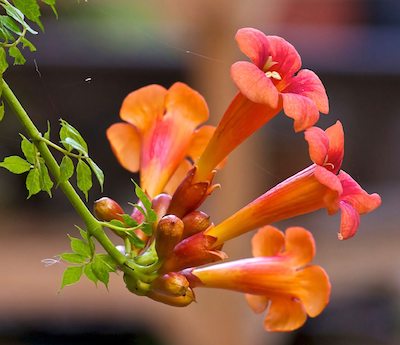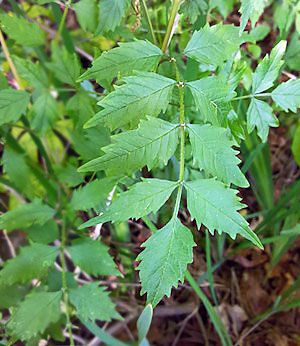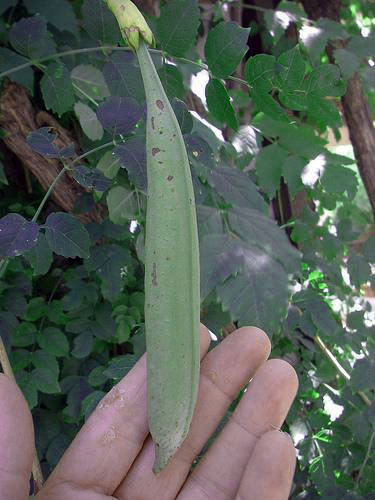Trumpet Creeper: Desired Vine or Invasive Weed?
By Ann M Mason, Fairfax Master Gardener Intern
 Some say, “Beauty is in the eye of the beholder.” For gardeners, there is a world of native plants that elicit mixed opinions. From the family Bignoniaceae, trumpet creeper (Campsis radicans), alternatively called trumpet vine, cow-itch and devil’s shoestring, is one of those.
Some say, “Beauty is in the eye of the beholder.” For gardeners, there is a world of native plants that elicit mixed opinions. From the family Bignoniaceae, trumpet creeper (Campsis radicans), alternatively called trumpet vine, cow-itch and devil’s shoestring, is one of those.
For some, this perennial woody vine is valued as an ornamental whose tubular red-orange flowers attract hummingbirds and butterflies and whose stems provide a habitat for ants. For others, this aggressive bully is a nuisance weed whose stems can reach up to 12 meters (about 39 feet), twine around trees and shrubs and sprawl over flower beds if not controlled.

Leaf of Trumpet Creeper
In full sun, the trumpet creeper produces clusters of attractive 8 cm (about 3 inch) long red orange flowers at the end of branches. These clusters of four to a dozen flowers appear from July through August and always attract Ruby-throated Hummingbirds (Archilochus colubris) in the area. In the fall, fruits appear as long, up to 8 to 13 cm (3 to 6 inches), narrow, flat or slightly roundish pods that contain many flat, winged seeds. In my shady garden under an ancient elm, I have never seen trumpet creeper bloom during the six years since first I spied it as a volunteer and started my battle with it.
Most of us see these vines growing and spilling over road sound barriers resplendent in their clusters of either red-orange flowers or their fruit — long brown pods. While this growth habit might be tolerated on sound barriers, such growth using the vine’s aerial rootlets will damage wood, stone or brick on our houses and related surfaces.

Fruit of Trumpet Creeper
Horticulturists report the tendency of trumpet creeper to send up new stems from deep roots (9 inches deep). So, digging up ALL the roots is one control. However, Purdue scientists report that stems will re-emerge within eight weeks from remaining root segments as small as 2 cm (0.8 inches) long! So, while digging up the roots is key, most horticulturists report that this is often insufficient, and herbicides are needed. There are many studies exploring many types of herbicides depending on whether this vine is mixed with crops or other ornamental plantings. Even with care in the selection of herbicides, persistence over multiple years is needed to get this vine under control.
For me, this weed deserves its common name of “cow-itch.” Even with my arms covered and fingers gloved, contact with the leaves causes an itchy burning sensation from a small red bumpy rash consistent with contact dermatitis. I wash my skin with soapy water, and the irritation subsides a bit and usually goes away in a day or so. This is irritation is reported in the literature and is the basis for the cow-itch name. I could not find the chemical associated with this irritation, but scientists have identified a long list of chemicals extracted from the leaves.
Regardless of how you view trumpet creeper in your garden, control of this aggressive, native woody perennial is essential.
Resources
• Trumpet Creeper (Campsis radicans), USDA Plant Guide
• Campsis radicans, Lady Bird Johnson Wildflower Center Plant Database, Austin, Texas
• Identification and Control of Trumpetcreeper (Campsis radicans) in Virginia, Kevin W. Bradley, and
Edward S. Hagood, Jr., Virginia Cooperative Extension Publication 450-143
• Trumpetcreeper: One Tough Plant, Glenn Nice, Bill Johnson, and Tom Bauman, Purdue Cooperative
Extension Service, Pest and Crop, April 21, 2006
• Trumpetcreeper, Home & Garden Information Center, University of Maryland Extension
• Campsis radicans, North Carolina Extension Gardener Plant Toolbox